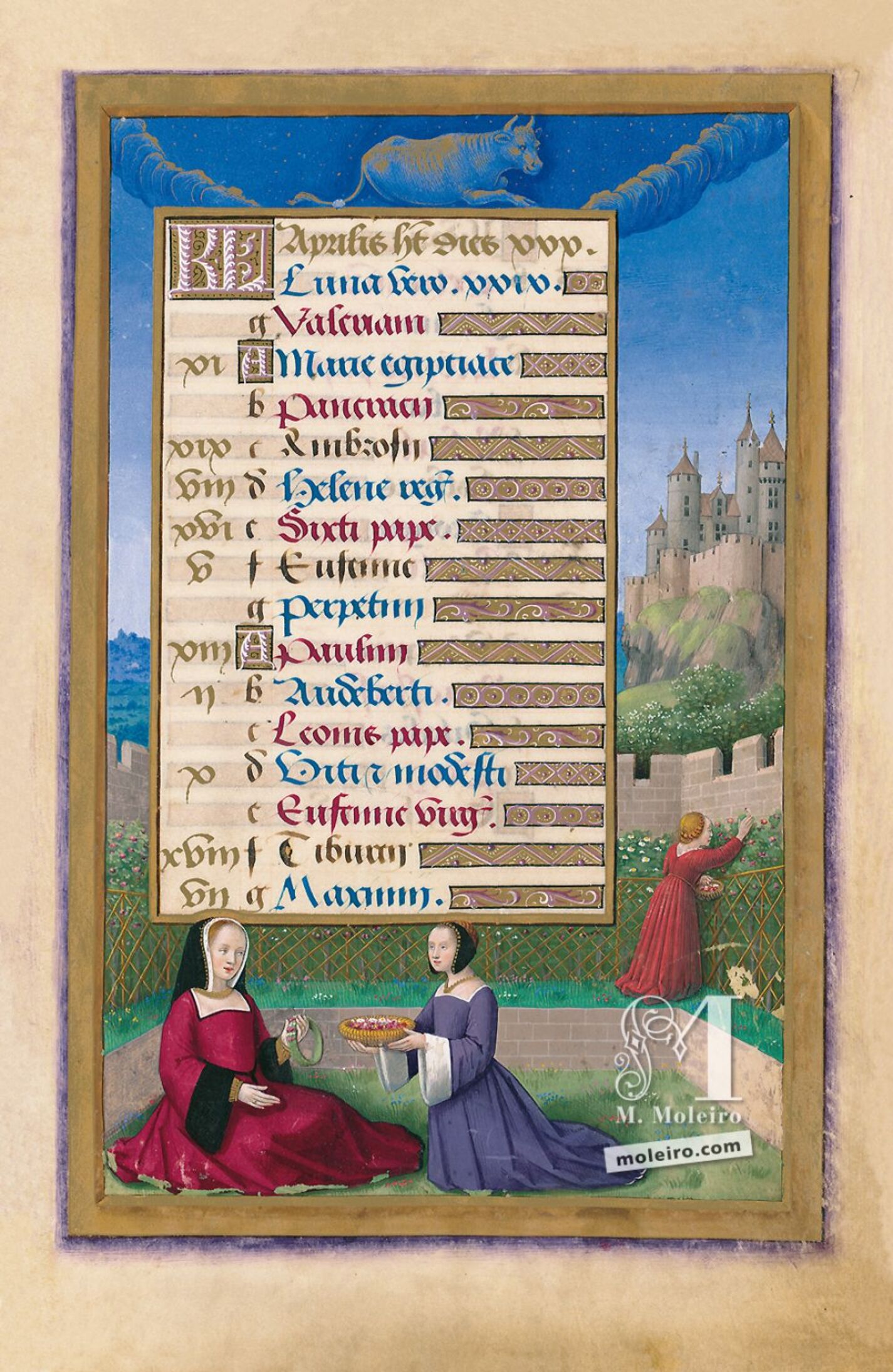The constellation of Taurus is portrayed as a recumbent bull in profile facing right. In keeping with the respective time of year, the sky is clearer and there is more vegetation and thorny bushes full of white flowers can be seen on the other side of the crenulated wall. On the nearer side, in a flower bed embellished with a lawn and a few flowers, sits Anne of Brittany on a cushion or small seat that is out of sight weaving a garland of white and red roses, a leisure activity fitting for young members of the nobility, i.e. weaving crowns of flowers which were traditionally gifts for young knights, in this instance, Louis XII. Alongside her is a chambermaid, on her knees as required by protocol, holding a gold wickerwork bowl of reddish and white roses out to her. On the right of the garden, upon an ashlar stone seat covered in grass, is a maiden picking flowers on the other side of golden, open-work trellises decorated with rhombuses and roses and putting them in a basket.
From the first quarter of the 14th century onwards, the April illustration was often given an aristocratic or upper-bourgeois meaning by depicting the activity of weaving a crown of flowers, the earliest origin of which was to be found in the portrayals of Flora incorporated into Gothic narrative language. In the illustrations of Psalters, books of hours, tacuina and the Trent frescoes, the incorporation of pastimes typical of the nobility and the upper bourgeoisie, in addition to farming tasks, was one of the characteristic traits of the cycles in Tuscan and French calendars. April featured not a farming task but the pleasure of using the senses, usually in a garden where lovers would meet to cut flowers, and make or give garlands. The feeling of love seems to follow the rebirth of nature, with April being the ideal setting for the pleasure garden. The part of the garden depicted here, intended to be a hortus conclusus (enclosed garden), is a private space offering privacy and seclusion designed with the lord in mind, the iconography of which has two basic focal points: extolling a form of mathematically domesticated nature – the image of an orderly universe – and the extolling of the sovereign. Since the painting by Jean Bourdichon is one of the earliest extant portraits of a figure in a garden, it is an integral part of the message intended to be conveyed by portraying human figures. It must be remembered, above all, that in the April scene the artist chose to depict Anne of Brittany busy at a noble pastime inside a hortus conclusus, forerunners of which exist in relation to royalty, portraying, in her capacity as sovereign, the high moral standards mentioned in the texts extolling her virtues written both during her lifetime and after her death: a queen of France had to be seen to be a respectable person. Hence, being a model of an honest woman, removed from all frivolity, she is busy at an otium cum dignitatem (dignified leisure) or courtly pastime referring to her high rank and her devotion as a loving wife.
In this painting, as mentioned, the queen’s face looks different from on f. 3r, having a more conventional appearance in keeping with the exact canons of female beauty of that time, i.e. a young appearance with which only women blessed by God’s grace were endowed, be they female saints or exceptional women. There is, in fact, no testimony of Anne of Brittany’s true appearance: royal chronicles of the 16th century never mention the queen’s appearance, dwelling only on her virtues, as numerous as those attributed to her during her lifetime. In short, Anne of Brittany altered a traditional image and converted it into a new symbol of power that strengthened her role as queen.
